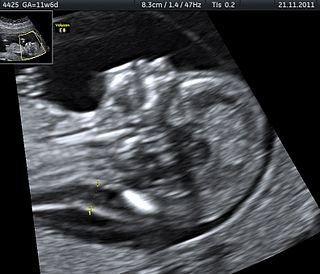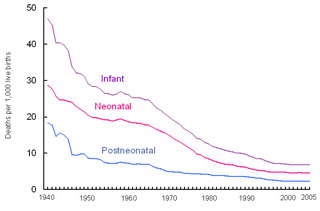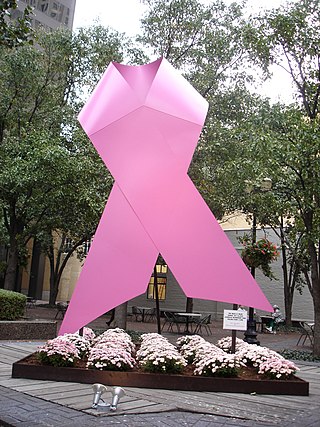
Miscarriage, also known in medical terms as a spontaneous abortion, is the death and expulsion of an embryo or fetus before it can survive independently. The term miscarriage is sometimes used to refer to all forms of pregnancy loss and pregnancy with abortive outcomes before 20 weeks of gestation.

In human reproduction, a live birth occurs when a fetus exits the mother showing any definite sign of life such as voluntary movement, heartbeat, or pulsation of the umbilical cord, for however brief a time and regardless of whether the umbilical cord or placenta are intact. After the fetus is expelled from the maternal body it is called a neonate. Whether the birth is vaginal or by caesarean section, and whether the neonate is ultimately viable, is irrelevant.

Stillbirth is typically defined as fetal death at or after 20 or 28 weeks of pregnancy, depending on the source. It results in a baby born without signs of life. A stillbirth can often result in the feeling of guilt or grief in the mother. The term is in contrast to miscarriage, which is an early pregnancy loss, and Sudden Infant Death Syndrome, where the baby dies a short time after being born alive.
The pink ribbon is an international symbol of breast cancer awareness. Pink ribbons, and the color pink in general, identify the wearer or promoter with the breast cancer brand and express moral support for women with breast cancer. Pink ribbons are most commonly seen during National Breast Cancer Awareness Month.

Pregnancy is the time during which one or more offspring develops (gestates) inside a woman's uterus (womb). A multiple pregnancy involves more than one offspring, such as with twins.
Prenatal development includes the development of the embryo and of the fetus during a viviparous animal's gestation. Prenatal development starts with fertilization, in the germinal stage of embryonic development, and continues in fetal development until birth.

Complications of pregnancy are health problems that are related to, or arise during pregnancy. Complications that occur primarily during childbirth are termed obstetric labor complications, and problems that occur primarily after childbirth are termed puerperal disorders. While some complications improve or are fully resolved after pregnancy, some may lead to lasting effects, morbidity, or in the most severe cases, maternal or fetal mortality.
In biology and medicine, gravidity and parity are the number of times a female has been pregnant (gravidity) and carried the pregnancies to a viable gestational age (parity). These two terms are usually coupled, sometimes with additional terms, to indicate more details of the female's obstetric history. When using these terms:

Nutrition and pregnancy refers to the nutrient intake, and dietary planning that is undertaken before, during and after pregnancy. Nutrition of the fetus begins at conception. For this reason, the nutrition of the mother is important from before conception as well as throughout pregnancy and breastfeeding. An ever-increasing number of studies have shown that the nutrition of the mother will have an effect on the child, up to and including the risk for cancer, cardiovascular disease, hypertension and diabetes throughout life.

Perinatal mortality (PNM) is the death of a fetus or neonate and is the basis to calculate the perinatal mortality rate. Perinatal means "relating to the period starting a few weeks before birth and including the birth and a few weeks after birth."
Pregnancy and Infant Loss Remembrance Day is an annual day of remembrance observed on October 15 for pregnancy loss and infant death, which includes miscarriage, stillbirth, SIDS, ectopic pregnancy, termination for medical reasons, and the death of a newborn. Pregnancy and infant loss is a common experience that has historically been complicated by broadly applied social and cultural taboos to stay silent, a condition that the World Health Organization advocates reversing in favor of open expression. A growing number of public figures have come out in support of open expression, with many leading by example through the disclosure of their personal experiences of pregnancy loss and infant death.

Breast Cancer Awareness Month (BCAM), also referred to in the United States as National Breast Cancer Awareness Month (NBCAM), is an annual international health campaign organized by major breast cancer charities every October to increase awareness of the disease and raise funds for research into its cause, prevention, diagnosis, treatment, and cure.
Wellbeing of Women is the only UK charity dedicated to funding research, education and advocacy across all of women's reproductive and gynaecological health, including menstruation, fertility, pregnancy, childbirth, gynaecological cancers, menopause and incontinence. It raises money to invest in medical research and the development of specialist doctors and nurses working in these fields. The charity also disseminates information and hosts regular webinars on women's health.

Breast cancer awareness is an effort to raise awareness and reduce the stigma of breast cancer through education about screening, symptoms, and treatment. Supporters hope that greater knowledge will lead to earlier detection of breast cancer, which is associated with higher long-term survival rates, and that money raised for breast cancer will produce a reliable, permanent cure.
Toxic abortion is a medical phenomenon of spontaneous abortion, miscarriage, or stillbirth caused by toxins in the environment of the mother during pregnancy, especially as caused by toxic environmental pollutants, though sometimes reported as caused by naturally occurring plant toxins
The Mariposa Trust is a charity in the United Kingdom founded by Zoë Clark-Coates, to support people who have suffered baby loss, in pregnancy, at birth or in infancy. It holds public Services of Remembrance, of any or no religious faith, across the UK to acknowledge the loss of a baby by their families, and by arranging specialist support divisions to help people with their associated grief and trauma. It is one of the organizations that supports baby loss awareness week.
A rainbow baby is a term for a child born to a family that has previously lost one or more children due to stillbirth, miscarriage, ectopic pregnancy, termination for medical reasons, or death during infancy. These subsequent pregnancies can bring "strong feelings of anxiety, guilt, and even fear" but also "immense joy, reflection, healing, and mixed emotions". The term "rainbow" is symbolic of the hope brought by the child after the emotional storm of the previous loss.

The colors pink and blue are associated with girls and boys respectively, in the United States, the United Kingdom and some other European countries.
Reproductive loss, sometimes reproductive grief, describes a potential emotional response to unsuccessful attempts at human reproduction or family-building. These experienced losses may include involuntary childlessness generally, pregnancy loss from all causes, perinatal death, stillbirth, infecundity and infertility from all causes, failed attempts to conceive, failed fertility treatments, failed gestational surrogacy procedures, and losses related to all dimensions of the adoption process. Responses to miscarriage, stillbirth, selective reduction and neonatal death are a subtype of reproductive loss called perinatal bereavement.










